The Queen was coming and the large contingent of locals at Wat Mahathat suddenly took on the guise of a hive of worker bees. I’d never seen that many Thais actually accomplishing something before. But then regardless of their sanuk approach to life, to the people of Thailand the royals matter. Greatly. And a visit by one is not something to be taken lightly. The required pomp and ceremony alone makes for a hectic work schedule. Wait until an hour before the planned arrival to make preparations, and that moves from hectic to frenetic. Which is the last thing you’d expect out of a visit to Bangkok’s Wat Mahathat.
Most visitors to Bangkok have heard of the Grand Palace and many add a visit there to their itinerary, even if once they get to the palace it is closed and they spend the day touring lesser wats, gem shops, and tailors instead. Just as many have heard of Wat Pho and its ginormous reclining Buddha, and most of them manage to sneak a visit in during their busy holiday schedule. Wat Mahathat isn’t on the radar of most touri, even though like Wat Pho it neighbors the Grand Palace and like Wat Pho it is a Royal Temple of the highest order. As large as the temple is, it doesn’t have the same draw as Wat Pho’s reclining Buddha or Wat Phra Kaew’s Emerald Buddha. Its main claim to fame according to the guide books is its large peaceful garden of palm trees tucked away at the back of the temple. Hardly a Kodak moment. And not a grand enough reason for most touri to consider a visit. But the locals know better. And if it is important enough to earn a visit from the Queen . . .

Winding alleyways filled with classrooms, monk housing, and minor buildings surround Wat Mahathat’s main courtyard.
If you plan on visiting Wat Mahathat, the first thing you have to do is to decide which Wat Mahathat to visit. There are four of them in the country. There’s one in Luang Prabang too if you don’t have enough to choose from in Thailand. If you planned your trip by photos you’ve seen, it is probably the one in Ayutthaya you are thinking of. Almost everyone has seen the iconic photo of a statue’s head enveloped by tree roots at the historical park there. The Wat Mahathat in Bangkok looks like many other local wats, lots of white walls, lots of red roofs, and lots of gold Buddha statues lined up in a row. But then since the one in Bangkok is closer for most touri, it’s Wat Mahathat Yuwarajarangsarit Rajaworamahavihara that you want. But calling it Wat Mahathat will do. If you are asking for directions to the wat from a local they’ll be wrong regardless if you use the temple’s full or abbreviated name. Wat Mahathat, by the way, means Temple of the Great Relic. I’m sure that is in no way a reference to the Queen.
The morning I visited Wat Mahathat, I didn’t know about the Queen’s visit. And the grove of palm trees wasn’t enough to peak my interest either. I’d been visiting the Wat Mahathat amulet market, which runs along Maharat Road at the back of the temple, though being the side closest to the river seemed to me to be the front of the complex. I knew the wat was there, but what enticed me to walk inside the grounds were the long narrow lanes of monk housing and minor buildings that make up a large part of the complex. Even during the week the amulet market is busy with lots of locals bustling about. Steeping into an oasis of tranquility had an appeal. And it was both serene and fascinating until I wound my way through the rural lanes and hit the main temple area. Then it was all about the Queen’s visit.
And the hordes of workers were both busy and excited about the event. Red carpets were being laid out, seating arranged – carefully and in strict accordance of rank inside the temple, and with an eye to squeezing in as many seats as possible outside in the viewing areas – freshly potted plants brimming with color were being hauled in and arranged, somewhat in competition with the elaborate floral arrangements being carried in a non-stop procession into the temple. The AV guys were busy stringing cords and cables for lighting and the PA system, making just as much of a rats nest out of their work as you typically see with electrical wires dangling from the sky along the city’s streets, and gaggles of elderly women manned a brigade of brooms to sweep clean the walkways that the other workers kept getting dirty yet again. And everyone stopped what they were doing to tell me how lucky I was to be visiting the wat when the Queen was coming. An hour an a half in advance to her visit, they all assumed I’d hit the jackpot and would grab a front row seat for the proceedings.
But in all due respect to her Royalness, the Great Flood of 2011 was also gearing up for a visit to the wat, and was already winning the battle against the amulet vendors out on the main street. For me, that scene was a greater draw. My primo seat went to some more deserving, and interested, local. But even then I still spent a few hours wandering through the complex, out to Na Phra That Road (where there is surprisingly a useful map of the complex posted) and then back into the temple again. There is a lot to see at Wat Mahathat, and a lot of history there too.
One of Bangkok’s oldest wats, originally called Wat Salak, it was built in the Ayutthaya period prior to Bangkok being named the country’s capital. Due to its location close to the Grand Palace, it has always had a tie-in with Thai royalty. King Rama I’s younger brother was responsible for its first renovation and had the temple renamed to Wat Nipphanaram. Several years later the king renamed it Wat Phra Sri Sanphet and then in 1803 renamed it Wat Mahathat Of Bangkok since relics of the Buddha are enshrined there. Young Prince Mongkut, who later became King Rama IV served as a monk there and also was responsible for some major renovations. It was given its current name in 1996, and today serves as the residence of the Supreme Patriarch, the head of the Mahanikai school of Buddhism, Thailand’s largest monastic order.
The main entrance to the wat on Na Phra That Road is usually closed. If you are coming from the direction of Sanam Luang your best bet is to walk through the smaller entrance at the corner of Phra Chan Road where you’ll pass an exquisite little wiharn that was part of the original temple as well as the wat’s elementary school. Toward the back you can cut through to the temple’s main courtyard, or exit onto Maharat Road and enter again through one of the numerous gates that lead through the sprawling complex of housing, offices, and classrooms. Wandering through the small alleyways provides a good sense of daily life at the wat, and if you meander over to where the Maha Chulalongkorn Buddhist University is located you’ll often find young friendly monks who’ll enjoy practicing their English while telling you about their life at the school.

Inside the ubosot statues of Buddhist nuns honoring The Buddha are one of the wat’s unusual features.
You’ll also find the entrance to the inner courtyard may be closed, but the doors are usually ajar and you should go ahead an walk right in. This is where the temple’s main buildings are, including what is believed to be the largest ubosot in Bangkok, an equally large wiharn, the small wiharn used by King Rama IV when he was a monk, and the large square-shaped chedi where the temple’s Buddha relics are enshrined. It’s a large expanse surrounded by cloisters filling with lines of Buddha statues, many of which serve as memorials to departed loved ones. The Buddha statues all in a row are an iconic photo taking opportunity, but you’ll notice the white columns holding up the roof of the cloisters will always seem skewered in your pictures; for some reason they have been built slanted inwards, so it’s the wat’s architecture, not your choice of libations the night before that is to blame.
The buildings take up most of the grounds, but what green areas there are are all formally landscaped. What you won’t find here are the crowds that fill Wat Pho and the Grand Palace. You’ll often have the entire area to yourself. Unless you choose to visit on the day the Queen is scheduled to drop by.
The quiet and tranquil grounds of the wat would seem to lend themselves well to peaceful reflection and meditation. And if you are interested in formalizing your knowledge of those activities, Wat Mahathat is home to the Vipassana Meditation Centre, also known as Section V, an International Buddhist Meditation Center, where visitors can attend a series of classes on Buddhism and meditation.
Classes in Vipassana meditation (insight meditation) are offered at Section V in English daily, and consist of an introductory meditation instruction followed by demonstrations of both sitting and standing meditation. The three hour programs are offered at 7:00 in the morning, 1:00 in the afternoon, and again at 8:00 in the evening. Longer stays, including accommodation and food can be arranged, but students are expected to follow an even stricter regimen of conduct than what is expected of those attending the three hour programs. And those requirements alone you may have a problem in meeting

The gardens in Wat Mahathat’s courtyard are well manicured and filled with topiaries often depicting Buddhist imagery.
Students are required to wear only white attire during the programs, (outfits are available for rent at the center). They are also asked to observe five basic Buddhist precepts, which may be problematic. These five rules, if you will, are the basic precepts all devout laypersons are expected to adhere to, so it’s more of an indoctrination into Buddhism that rules demanded by the school.
Perhaps while in attendance at the classes you may have little problem with abiding by these life rules; staying true to your teachings afterwards may be more difficult. The five basic precepts are that you shall not kill, shall not steal, shall refrain from sexual misconduct, shall refrain from gossip, lies, and verbal abuse, and shall also abstain from intoxication liquor and drugs. If you plan on indulging in a longer program three more precepts come into play, those that most Buddhists adhere to during major religious holidays. They are no eating after noon, no sleeping on a bed, and no entertainment – so no TV, or music, and definitely no heading out to watch a gogo bar show.
Wat Mahathat is open daily from 9:00 a.m. to 5:00 p.m. If you want to experience the amulet market too, Sundays are your best bet, that’s when the market really gets swinging. You can get to the wat by bus, or for about 90 baht by taxi from the Silom area. But your best entrance is by riverboat, which from the Central Pier can run as little at 14 baht each way. Get off at the same pier as you would for the Grand Palace, the Chang Pier, and turn left at the first major road, Thanon Maharat. The amulet market starts immediately along both sides of the street and there are several entrances to the wat along the right-side of Maharat Road. But if you want to enter like a queen, you’ll need to head up a block and use the temple’s main entrance.
Related Posts You Might Enjoy:

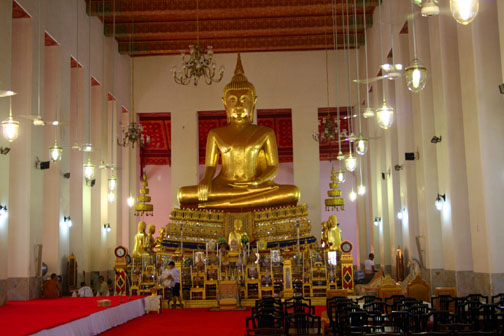
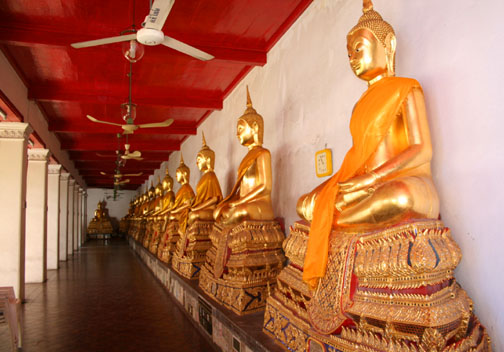
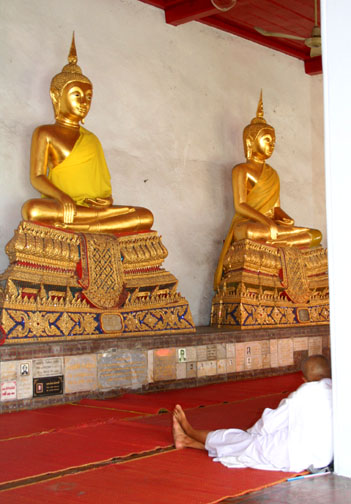
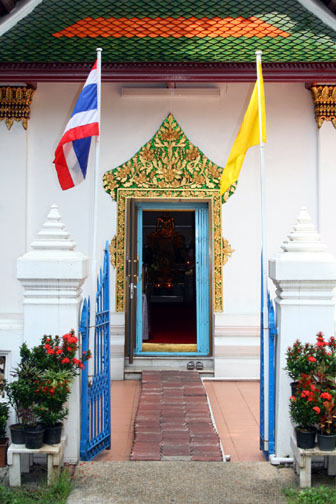
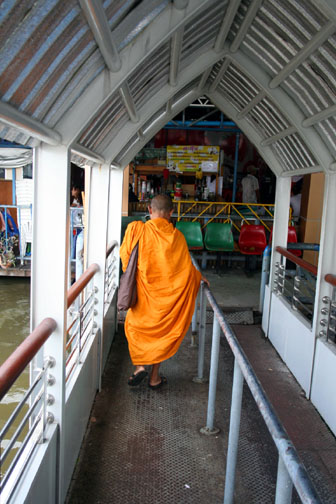

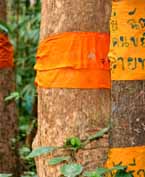


i was on the sky train on saturday, and passing from one platform to another, two young monks got on the same train as me . there was plenty of room, as it was early one of the monks stood as close to me as he could and seemed very keen to lean on me when ever the train went around a bend .. when i got off i had to ask him .excuse me please … he said o.k. and gave a big smile ..
im sure being as he was a monk i couldnt say anything to him about touching me .. or ask for a tip. shame he was rather ugly 🙁
Huh. Now that could have been a Monk Shot! of an entirely different sort!